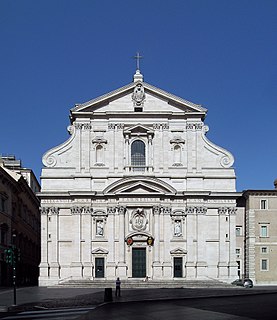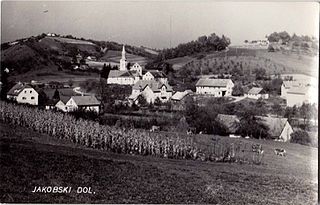| Pesniški Dvor | |
|---|---|
| Coordinates: 46°36′3.49″N15°41′36.17″E / 46.6009694°N 15.6933806°E Coordinates: 46°36′3.49″N15°41′36.17″E / 46.6009694°N 15.6933806°E | |
| Country | |
| Traditional region | Styria |
| Statistical region | Drava |
| Municipality | Pesnica |
| Area | |
| • Total | 1.47 km2 (0.57 sq mi) |
| Elevation | 267.7 m (878.3 ft) |
| Population (2002) | |
| • Total | 101 |
| [1] | |
Pesniški Dvor (pronounced [ˈpeːsniʃki ˈdʋoːɾ] ) is a settlement in the Municipality of Pesnica in northeastern Slovenia. It lies in the Pesnica Valley in the traditional region of Styria. The entire municipality is now included in the Drava Statistical Region. [2]

A municipality is usually a single administrative division having corporate status and powers of self-government or jurisdiction as granted by national and regional laws to which it is subordinate. It is to be distinguished (usually) from the county, which may encompass rural territory or numerous small communities such as towns, villages and hamlets.

The Municipality of Pesnica is a municipality in northeastern Slovenia. The center of the municipality is Pesnica pri Mariboru, a suburb near Maribor. It lies at the western end of the Slovene Hills in the Upper Pesnica Valley. The area was part of the traditional region of Styria. It is now included in the Drava Statistical Region as part of the Pesnica Administrative Unit. The main economic activities in the area are tourism, transportation, viticulture, vinemaking, craftsmanship and farming.

Slovenia, officially the Republic of Slovenia, is a sovereign state located in southern Central Europe at a crossroads of important European cultural and trade routes. It is bordered by Italy to the west, Austria to the north, Hungary to the northeast, Croatia to the southeast, and the Adriatic Sea to the southwest. It covers 20,273 square kilometers (7,827 sq mi) and has a population of 2.07 million. One of the successor states of the former Yugoslavia, Slovenia is a parliamentary republic and a member of the United Nations, of the European Union, and of NATO. The capital and largest city is Ljubljana.
The name Pesniški Dvor literally means 'Pesnica Manor'. It gets its name from a 17th-century Baroque mansion (Slovene : dvor) in the settlement. Until 1935 it was in the possession of St. Paul's Abbey in the Lavanttal. After the Second World War it was used by an agricultural conglomerate. Despite being protected as a monument of cultural heritage by the Slovenian Ministry of Culture, it is in a very bad state of repair. [3]

Baroque architecture is the building style of the Baroque era, begun in late 16th-century Italy, that took the Roman vocabulary of Renaissance architecture and used it in a new rhetorical and theatrical fashion, often to express the triumph of the Catholic Church. It was characterized by new explorations of form, light and shadow, and dramatic intensity. Common features of Baroque architecture included gigantism of proportions; a large open central space where everyone could see the altar; twisting columns, theatrical effects, including light coming from a cupola above; dramatic interior effects created with bronze and gilding; clusters of sculpted angels and other figures high overhead; and an extensive use of trompe-l'oeil, also called "quadratura," with painted architectural details and figures on the walls and ceiling, to increase the dramatic and theatrical effect.

A mansion is a large dwelling house. The word itself derives through Old French from the Latin word mansio "dwelling", an abstract noun derived from the verb manere "to dwell". The English word manse originally defined a property large enough for the parish priest to maintain himself, but a mansion is no longer self-sustaining in this way. Manor comes from the same root—territorial holdings granted to a lord who would "remain" there—hence it is obvious how the word mansion got its meaning.

Slovene or Slovenian belongs to the group of South Slavic languages. It is spoken by approximately 2.5 million speakers worldwide, the majority of whom live in Slovenia. It is the first language of about 2.1 million Slovenian people and is one of the 24 official and working languages of the European Union.






